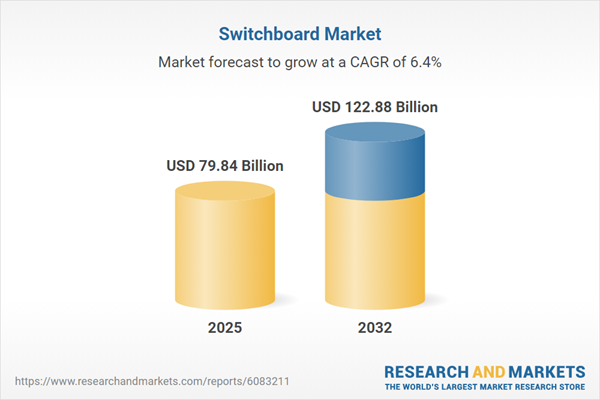Speak directly to the analyst to clarify any post sales queries you may have.
The telecommunications device market is navigating a phase of unprecedented evolution, with rapid advances in technology, shifting regulations, and global supply chain complexity reshaping decision-making for leaders across the sector.
Market Snapshot: Growth at Scale in the Telecommunications Device Market
Accelerating demand for robust connectivity and enterprise-grade digital tools is fueling strong expansion in the telecommunications device market. As technology adoption cycles shorten and device performance expectations rise, the market is experiencing notable growth. The Switchboard Market advanced from USD 75.06 billion in 2024 to USD 79.84 billion in 2025 and is forecast to reach USD 122.88 billion by 2032, at a CAGR of 6.35%. This market environment is shaped by increasing device sophistication, swift network upgrades, and substantial movement in international trade regulations. Changes in supply chain priorities, such as local tariff fluctuations and a heightened focus on sustainable sourcing and manufacturing practices, are altering risk profiles and opportunity landscapes for all industry stakeholders.
Scope & Segmentation: Telecommunications Device Market Breakdown
This report delivers an actionable segmentation analysis to support strategic decisions and risk evaluation for senior executives:
- Device Types: Includes smartphones from 2G to 5G generations, feature phones, and tablets, covering a wide range of user and enterprise needs.
- Operating Systems: Spans Android (versions 10–12), iOS (14, 15), Linux, and Windows, addressing the varied requirements for enterprise fleet integration and consumer functionality.
- Application Categories: Supports commercial functions such as education, finance, and productivity; consumer uses including gaming, messaging, streaming, and social media; and enterprise integration into platforms like CRM, ERP, and SCM.
- Distribution Channels: Reaches end users via offline networks—channel partners, retail stores, direct sales—and growing online pathways including company websites, ecommerce, and mobile apps; each route has unique adoption characteristics.
- Industry Verticals: Devices are adopted across sectors such as banking, financial services, insurance, government, defense, healthcare, manufacturing, and retail, each influencing specific compliance and feature needs.
- Enterprise Tiers: Solutions cater to large, medium, and small organizations, reflecting differing procurement and deployment priorities.
- Regions: Coverage includes the Americas (United States, Canada, Mexico, Brazil, Argentina, Chile, Colombia, Peru), Europe, Middle East, Africa (United Kingdom, Germany, France, Russia, Italy, Spain, Netherlands, Sweden, Poland, Switzerland, UAE, Saudi Arabia, Qatar, Turkey, Israel, South Africa, Nigeria, Egypt, Kenya), and Asia-Pacific (China, India, Japan, Australia, South Korea, Indonesia, Thailand, Malaysia, Singapore, Taiwan).
- Company Coverage: Profiles leading players such as NEC Corporation, Avaya Inc., Cisco Systems, Huawei Technologies, Panasonic Corporation, ZTE Corporation, Atos SE, Alcatel-Lucent Enterprise SAS, Mitel Networks, and Ericsson.
Key Takeaways for Senior Decision Makers
- Integration of 5G and adoption of edge computing are reshaping market expectations, prompting organizations to rethink R&D strategies and increase organizational agility.
- United States tariff policy updates have highlighted the importance of flexible sourcing and production models to control operational costs and enable geographic risk mitigation.
- Global changes in data privacy standards and governance are requiring organizations to localize procurement and strengthen compliance frameworks, with an emphasis on reducing regulatory exposure.
- Device sustainability is moving into focus, influencing choices of materials and design to support decarbonization and meet environmental standards across global markets.
- Regional user behaviors are driving differentiated go-to-market strategies—North America shows preference for premium solutions, Latin America seeks greater cost efficiency, and Asia-Pacific is prioritized for its high adoption rate and deployment scale.
Tariff Impact: Navigating Cost Inflation and Geographic Shifts
Tariff actions introduced in the United States during 2025 have increased supply chain expenses, encouraging firms to diversify procurement by seeking regions with more favorable trade terms and advancing on domestic or nearshore production. This ongoing shift is increasing reliance on automation and the creation of inter-regional manufacturing partnerships. For companies with less diverse production footprints, joint ventures and co-manufacturing are emerging as essential tools for maintaining competitiveness in the face of sustained cost escalation and logistics uncertainties.
Research Methodology & Data Sources
The research is built on dual pillars: comprehensive analysis of public filings, trade documentation, and regulatory records, combined with in-depth interviews with manufacturers and network operators. All findings are validated through cross-referenced financial disclosures, shipment data, macroeconomic trends, and expert peer review within the industry.
Why This Report Matters
- Empowers senior executives to shape effective market entry, technology investment, and supply chain strategies while maintaining compliance.
- Delivers targeted insights into high-potential segments and regional dynamics, supporting business transformation and sharper market positioning.
- Facilitates informed decision-making on risk mitigation amid shifting regulation, sustainability demands, and evolving international trade conditions.
Conclusion
Equipped with detailed sector insights, executive teams can steer confidently through transformative trends, minimizing risk and capturing new business value as the telecommunications device market continues to evolve.
Table of Contents
3. Executive Summary
4. Market Overview
7. Cumulative Impact of Artificial Intelligence 2025
Companies Mentioned
The companies profiled in this Switchboard market report include:- NEC Corporation
- Avaya Inc.
- Cisco Systems, Inc.
- Huawei Technologies Co., Ltd.
- Panasonic Corporation
- ZTE Corporation
- Atos SE
- Alcatel-Lucent Enterprise SAS
- Mitel Networks Corporation
- Telefonaktiebolaget LM Ericsson (publ)
Table Information
| Report Attribute | Details |
|---|---|
| No. of Pages | 191 |
| Published | October 2025 |
| Forecast Period | 2025 - 2032 |
| Estimated Market Value ( USD | $ 79.84 Billion |
| Forecasted Market Value ( USD | $ 122.88 Billion |
| Compound Annual Growth Rate | 6.3% |
| Regions Covered | Global |
| No. of Companies Mentioned | 11 |









